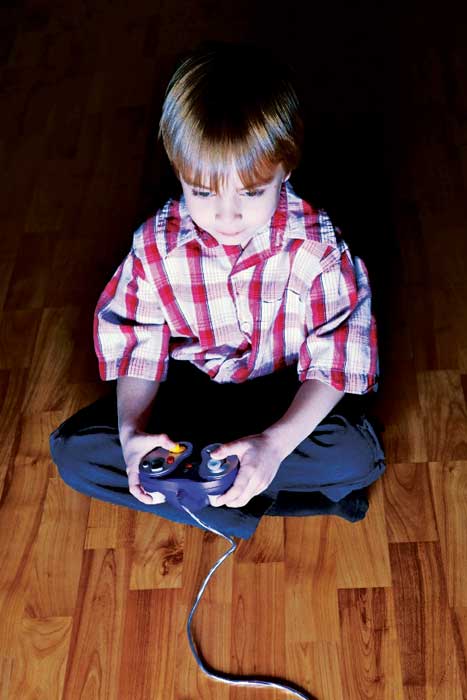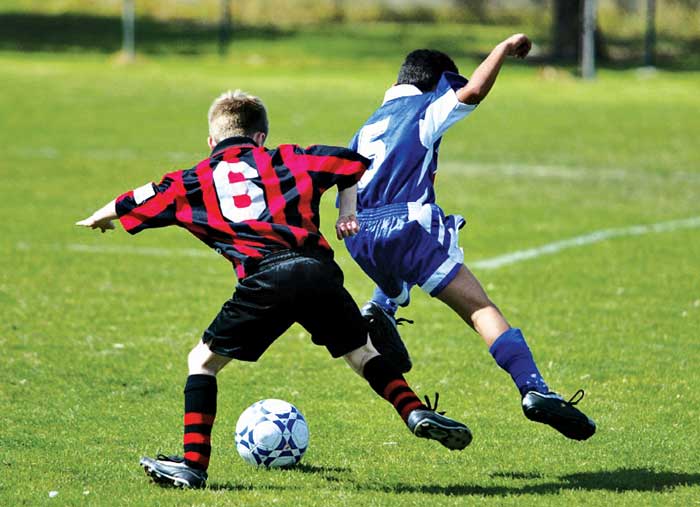
How do the risks of sports compare to the damage of too much sedentary screen time?
Ever notice how some of those “healed” injuries in youth catch up with us later on? For instance, no matter how quietly I tiptoe up the stairs late at night, my wife always hears me coming. That’s because my ankles crack with each step, like the Tin Man of Oz—a sequel to basketball sprains of my youth.
Despite injury risks, exercise is fun and essential to those of us who aren’t hunter-gatherers—and a healthy habit to instill in kids. But it can be hazardous and surprisingly expensive for parents. For example, the average cost of an inpatient emergency room visit for a kid’s sports-related injury is over $20,000. Holy cow! That’s on par with tuition.
For our kids, how do such risks compare to the damage of too much sedentary screen time? Should we encourage them to play “risky” contact sports in lieu of Angry Birds or Call of Duty? When considered on a societal scale, there is plenty of data indicating sports and exercise are worth the associated risks.
But how can we evaluate and balance such risks? Or know if we’re better off signing up our kids for summer soccer or for ballet, or if we ought to tone down our jogging and turn up our Pilates? As we surf the web to learn more, we’re engulfed by increasing rates of ACL knee traumas, widespread football concussions, and repetitive stress injuries we can’t even pronounce. While one study seems to say one thing, another indicates the opposite. For example some injury rates are reported per hour of play and others per hour of practice, or per year, and all yield different results. Per hour of play, boys’ hockey, rugby and soccer have the highest injury rates; for girls it is soccer, then basketball and gymnastics. For really severe injuries it’s cheerleading and football. But per hour of practice, cross-country running seems to be most injury-causing for both boys and girls. Not what I expected…but what’s left of my knee cartilage aches in agreement.
So how can you filter this information and extract the parts relevant to you? One approach is to examine the risk of sports injuries in young kids and in teens, and use this data to temper exercise choices, and to shape a fitness strategy.
Much of the data is sobering. At least 1 in 15 of all youth sports participants go to the emergency room each year for a sports injury (remember that $20,000?), and most injuries occur in practice not in games. This risk is repeated every year a kid plays sports—in or out of school. Fingers crossed for good health insurance. Even more mind-boggling…up to 1 in 5 high-schoolers per-month may experience a sports injury bad enough to see a nurse or a doctor but not require an ER visit. Let’s see…I’ve got three kids, multiplied by three months per year for each sport, modified by the amount of time they spend playing vs. practicing, times a 6.7 percent minimum incident injury rate, times the number of sports they play, times 12 years of sports activity per kid, times…oh-my-goodness, my head just exploded from the arithmetic!

How do the risks of sports compare to the damage of too much sedentary screen time?
So should we encourage recreational or solo exercise instead of team sports? On one hand, contact- and collision-filled team sports have the highest frequency of minor- or medium-level injuries such as contusions and repetitive-stress injuries. Yet the most severe injuries occur in recreational activities and in individual sports. Some of these are due to physiological differences, such as girls’ higher knee injury rates in cutting or jumping sports, whereas others are position- or sports-specific. For example, who knew that gymnasts, ice hockey players and ballet dancers have amazingly high lumbar injury rates?
And concussions? Rates are high for lacrosse and soccer, but for football the rates are mind-blowing. Puns aside, technological modifications such as improved helmet design have not significantly reduced incident rates, nor in extreme activities like equestrian or snowboarding. In some cases concussion rates are actually rising. In part this is because concussions are not usually associated with easy-to-recognize symptoms, like loss of consciousness, and in part because it is difficult to evaluate the phenomenon of “risk compensation.” Risk compensation is where players who have better protective gear may become more aggressive or different in their style of play. Like an arms race, a sport can escalate with each new technological advance. Witness the padded suits now worn under the oversized jerseys and shorts of many college and pro basketball players.
But what about non-sporting injuries—for example from PE class or kickball in the park? This information is relevant to all of us who exercise recreationally. In these categories, youth injury rates tend to be higher than in organized sports, about 1 in 9; and rates are highest for those with low levels of regular physical activity. The message: approach exercise gradually and carefully when migrating from a couch-bound lifestyle, or when prying screen-bound kids into an exercise routine. And just for the record, trampolines and bouncy castles can be more dangerous than any of the sports we’ve discussed thus far.
So how might we put all these risks in perspective? A key “grain of salt” is right in front of us. Seniors. They are the you of the future, or our kids a half-century from now. What were the effects of the sports they played in their youth and which ones do they still participate in? The latter are the sustainable, lifelong activities that will make up the bulk of our body’s exercise experience. So while kids’ injury rates are helpful to examine, the other end of the age spectrum gives insights too.
Try collecting the data for yourself. Go to the gym/park/studio/mountains and count the number of seniors participating in 10 different activities. Unless you’re hanging around with Richard Branson and his buddies, you probably won’t find many doing extreme sports. How many are playing everyday contact sports like football/soccer/basketball/field-ice-hockey? Prediction: Not many. How many are playing non-contact sports like running/biking/surfing/tennis/golf? Prediction: Some. How many walk, hike, swim, dance or do yoga/tai-chi/qigong? Prediction: Most. What follow-up questions might make sense to ask next? How many of them were injured while doing these activities? Which group do you predict has the fewest injuries?
So for kids, or for times in our life when we’re able to engage in organized sports…the next steps might be: First: don’t worry too much, especially if you’re a parent of young ones. Parental fear and perception of injury can result in reduced youth sports participation, especially among daughters, and often doesn’t result in kids using increased caution while participating in sports. Second, for activities you have interest in, dive into “the data” on risks, injury types and solutions for avoidance. Perhaps begin by surfing sites of the NSCA, NCCSI, NIH, BJSM, AAP or CDC. Third, strategize involvement, so you know what to recognize and where rest recovery, technique instruction, preventative conditioning or coaching can make a difference. Fourth, temper all of this with what you know about the specific characteristics and history of those involved. Exercise is fun but an evolving routine!
Meanwhile, I’m going to go ice my elbow—it is sore from too much mousing.
James “Whitey” Hagadorn, PhD, is a scientist at the Denver Museum of Nature & Science. Suggestions and comments welcome at jwhagadorn@dmns.org.



0 Comments